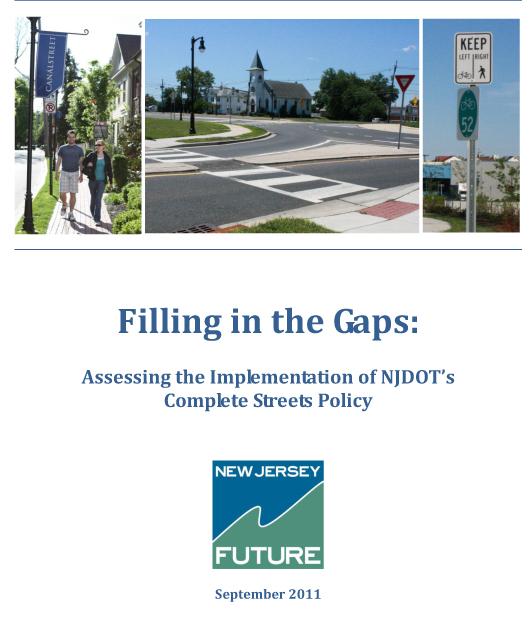New Jersey Future Blog
Incomplete Report Card for Complete Streets
September 7th, 2011 by New Jersey Future staff
- The New Jersey Department of Transportation adopted a Complete Streets policy in December 2009, calling for any new road-building projects to accommodate all users, not just drivers. Since then, only one project has been exempted from this policy.
- The DOT has also amended its Local Aid program to give additional priority to projects from municipalities that have adopted their own Complete Streets policies. So far, 13 municipalities have done so.
- Although the DOT spends hundreds of millions of dollars a year on resurfacings, it does not apply its Complete Streets policy to these projects.
Reforms Advancing, Need to Seize More Opportunities
Drive down most roads in New Jersey and you’ll likely see them: sidewalks that stop and start intermittently, strung together by worn-out grass. It’s a common sight across the state, the result of road design policies geared solely toward cars, with little or no consideration for other users — even though an estimated one-third of New Jersey residents don’t drive. The resulting landscape is inhospitable and dangerous for non-drivers; between 2000 and 2009, there were 1,514 pedestrian fatalities in New Jersey.
In an attempt to enhance safety and make roads more accommodating to bicyclists and pedestrians, the state Department of Transportation adopted a Complete Streets policy in 2009. This policy directs the department to design new roads and retrofit old ones to accommodate all users, not just drivers. Now, some 20 months later, New Jersey Future has taken a look at how the department has implemented the policy in a recently released report(pdf).
Since adopting its Complete Streets policy, the DOT has revised its project review process to give bicycle and pedestrian (bike/ped) design considerations greater priority. Previously, a bike/ped subject-matter expert at the department would give input only at the beginning of the design process; now this expert’s sign-off is required at every juncture in the multi-step process, ensuring that bike/ped features are not arbitrarily eliminated. The department has also amended its Local Aid program to give priority to municipalities that have adopted their own Complete Streets policies.
While these two reforms are significant steps in the right direction, New Jersey Future’s analysis also found missed opportunities for the department to implement its policy. The greatest missed opportunity relates to the department’s resurfacing program, which spends hundreds of millions of dollars each year repaving roads in the state. While the department contends that the expense of adding bike/ped elements, particularly in acquiring rights-of-way, makes full-scale Complete Streets implementation for these projects unfeasible, it neglects to consider lower-cost alternatives, such as restriping the existing roadway or installing traffic-calming measures.
Counties, Towns Hold Key to Future Success
In addition to missed opportunities, the DOT’s Complete Streets policy is limited in its scope. For all its clout, the DOT controls only about 10 percent of roads in the state; the rest are controlled by counties and municipalities. Only 13 of the state’s 566 municipalities and one of the state’s 21 counties have adopted their own Complete Streets policies for roads under their control. Whether the changes to the DOT’s Local Aid program will provide sufficient incentive for more to follow remains to be seen.
Moreover, New Jersey Future’s analysis found that the quality of local policies varies widely, in part because there are no uniform standards for what these policies should contain. The DOT can help address this by creating minimum standards that local policies must meet in order to qualify for priority funding though the Local Aid program.
It is clear that the DOT’s Complete Streets policy will help reshape state highways in the coming decades. The real test for the policy, however, will ultimately come at the local level. Any wide-scale movement to make roads across New Jersey safer and more hospitable to bicyclists and pedestrians will have to involve not only the state DOT, but the widespread participation of county and local transportation agencies as well.
Read New Jersey Future’s full analysis. Filling in the Gaps: Assessing the implementation of NJDOT’s Complete Streets Policy.


















This article is excellent in bringing the complete streets initiative into focus and framing some next steps. However, given limited resources and the diverse local context of roadway infrastructure, a systems based assessment approach would better enable priority setting across modes and networks to deliver safe, convenient, and attractive accessibility and mobility reflective of each community’s vision and built environment for all users. One size does not fit all.
Nice report and its great to see NJ Future step forward to take a critical but constructive look at NJDOT’s implementation of its Complete Street Policy. You’re so right to say that it’s implementation has been “incomplete” so far.
The lack of a single photo of a bike lane painfully demonstrates the manifested reality of NJDOT’s prior policies regarding bicycle access.
I’m sorry but despite the great people working hard on bike/ped issues in the NJDOT offices, the agency as a whole still lags far behind many of its contemporaries in getting useful infrastructure built for its constituents. Even some of NJDOT’s recently completed projects that it touts as being highly bicycle and pedestrian “friendly”, like Rt 18 in New Brunswick and the Rt 36 Navasink Bridge in Atlantic Highlands, have significant design shortcomings.
Great analysis Dan!
In the last five years, NJDOT has gradually but steadily moved away from its position as a national leader in creating 21st Century Transportation. The reins of the agency are now in the hands of the Production unit — Capital Program Management — whose leadership is only interested in concrete and steel. Policies and investment are now reverting to a 1960s model; keeping the roads and bridges open is considered an end in and of itself, instead of a means to helping New Jersey achieve its goals. Investment is directed to the next priority on the Pavement and Bridge Management systems, and no one bothers to check about whether those investments are being directed to segments of the highway system that were important in 1960 but no longer important today. While other state and city DOTs realize that other investments — bicycle and pedestrian infrastructure, integrating land use considerations, and 21st Century intersection solutions such as roundabouts — can accomplish far more statewide goals than “pounding the pavement”, NJDOT keeps dragging chains across its bridge decks (to find voids) and riding around in cars (measuring how bumpy the pavement is.
Excellent article – I’d like to encourage everyone to contact your municipal and county officials and urge them to implement a Complete Streets policy. To get from point A to point B today, we use a transportation network that’s operated by different jurisdictions with inconsistent policies. This needs fixing – even with consistent policies, implementation takes decades. New Jersey DOT and Pennsylvania DOT published the Smart Transportation Guidebook in 2008, which details flexible, Complete Streets solutions to different types of roads depending on the surrounding land use context. We should follow these excellent guidelines.